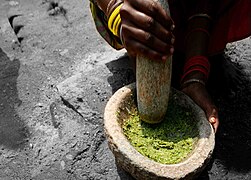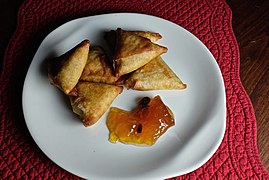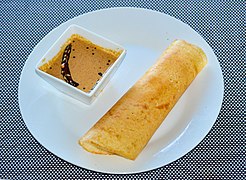
A chutney is a spread in the cuisines of the Indian subcontinent. Chutneys are made in a wide variety of forms, such as a tomato relish, a ground peanut garnish, yogurt or curd, cucumber, spicy coconut, spicy onion or mint dipping sauce.

Indian cuisine consists of a variety of regional and traditional cuisines native to the Indian subcontinent. Given the diversity in soil, climate, culture, ethnic groups, and occupations, these cuisines vary substantially and use locally available spices, herbs, vegetables, and fruits.

Trinidad and Tobago cuisine is the cuisine of the Caribbean island state of Trinidad and Tobago. It reflects a fusion of African, Creole, Indian-South Asian, Chinese, Amerindian, Arab, European, and Latin American-Spanish-Portuguese cuisines.

A relish is a cooked and pickled product made of chopped vegetables, fruits, pickles or herbs and is a food item typically used as a condiment to enhance a staple. Examples are chutneys and the North American relish, a pickled cucumber jam eaten with hot dogs or hamburgers. In North America, the word "relish" is frequently used to describe a single variety of finely-chopped pickled cucumber relish, such as pickle, dill and sweet relishes.

Garlic chutney, also referred to as lahsun chutney, lahsun ki chutney, lehsun chutney and bellulli chutney, is a chutney, originating from the Indian subcontinent, made from fresh garlic, dry or fresh coconut, groundnuts and green or red chili peppers. Cumin and tamarind are also sometimes used as ingredients. It is prepared in both wet and dried forms. The wet variety is made with fresh grated coconut and is typically served immediately after preparation.

Sri Lankan cuisine is known for its particular combinations of herbs, spices, fish, vegetables, rices, and fruits. The cuisine is highly centered around many varieties of rice, as well as coconut which is an ubiquitous plant throughout the country. Seafood also plays a significant role in the cuisine, be it fresh fish or preserved fish. As a country that was a hub in the historic oceanic silk road, contact with foreign traders brought new food items and cultural influences in addition to the local traditions of the country's ethnic groups, all of which have helped shape Sri Lankan cuisine. Influences from Indian, Indonesian and Dutch cuisines are most evident with Sri Lankan cuisine sharing close ties to other neighbouring South and Southeast Asian cuisines.

Tamil cuisine is a culinary style originating in the southern Indian state Tamil Nadu and other parts of South Asia like Sri Lanka. Both Vegetarian cuisine and Non-Vegetarian cuisine is popular among the Tamil people and has been since ancient times. However, meats along with rice, legumes and lentils are also popular. Dairy products and tamarind are used to provide sour flavors. On special occasions, traditional Tamil dishes are served in a traditional manner, using banana leaves in place of utensils. After eating, the banana leaves are then used as a secondary food for cattle. A typical breakfast meal consists of idli or dosa with chutney. Lunch includes Rice, sambar, Curd, kuzhambu, and rasam.

Maharashtrian or Marathicuisine is the cuisine of the Marathi people from the Indian state of Maharashtra. It has distinctive attributes, while sharing much with other Indian cuisines. Traditionally, Maharashtrians have considered their food to be more austere than others.

A South Asian pickle, known as achar, athanu, loncha, oorugai, or avakaai in the South, is a pickled food, native to the Indian subcontinent, made from a variety of vegetables and fruits, preserved in brine, vinegar, or edible oils along with various Indian spices.

South Indian cuisine includes the cuisines of the five southern states of India—Andhra Pradesh, Karnataka, Kerala, Tamil Nadu and Telangana—and the union territories of Lakshadweep, Pondicherry, and the Andaman and Nicobar Islands.There are typically vegetarian and non-vegetarian dishes for all five states. Additionally, all regions have typical main dishes, snacks, light meals, desserts, and drinks that are well known in their respective region.

Saraswat cuisine is the cuisine of the Saraswat Brahmins from the Konkan region on the western coast of India. Saraswat cuisine differs within the Saraswat Brahmin subsects and within the Konkan-Canara region. Saraswat cuisine originally hails from the Konkan region including Uttara Kannada, Udupi district, Dakshina Kannada, Damaon, and Goa, India. Saraswat cuisine is popular served in many restaurants throughout the western coast of India, and especially in the cities of Bombay and Bangalore. Each variation has its unique flavour and makes uses of different vegetables and fruits available in the region. Saraswat cuisine is usually pesco-vegetarian, except acharyas and purohits who follow a strictly saatvik vegetarian diet. According the Saraswat folklore, fish meats are regarded as sea vegetables. Historically, they have refrained from eating any terrestrial animals in general.
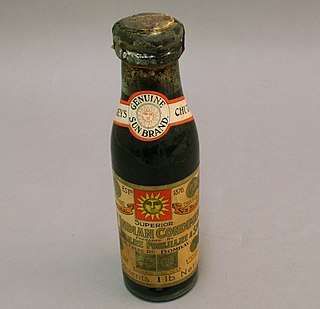
Major Grey's Chutney is a type of chutney, reputedly created by a 19th-century British Army officer of the same name who, though likely apocryphal, presumably lived in British India. Its characteristic ingredients are mango, raisins, vinegar, lime juice, onion, tamarind extract (occasionally), sweetening, and spices.
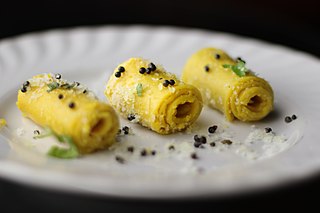
Khandvi, also known as Patuli, Dahivadi or Suralichi Vadi, is a savory snack in Maharashtrian cuisine as well as in Gujarati cuisine of India. It consists of yellowish, tightly rolled bite-sized pieces and is primarily made of gram flour and yogurt.

Telugu cuisine is a cuisine of South India native to the Telugu people from the states of Andhra Pradesh and Telangana. Generally known for its tangy, hot and spicy taste, the cooking is very diverse due to the vast spread of the people and varied topological regions.

Kasundi is the Asian or Bengali variety of mustard sauce or relish. It has the pungent paste of fermented mustard seeds, spices and sometimes dried mangoes, dried Indian plum and olives. Kasundi is popular as a dipping sauce in Bengali cuisine.




